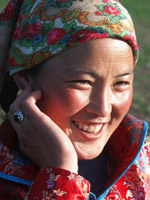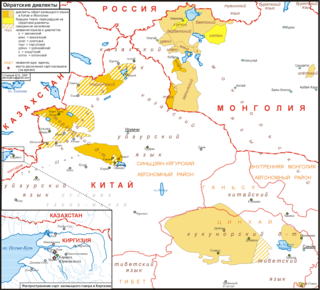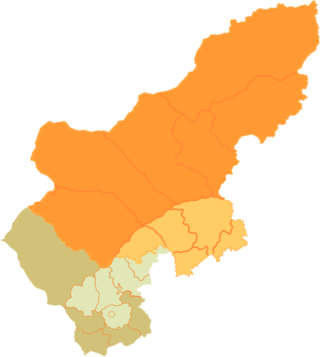Related Research Articles

Mongolian is the principal language of the Mongolic language family that originated in the Mongolian Plateau. It is spoken by ethnic Mongols and other closely related Mongolic peoples who are native to modern Mongolia and surrounding parts of East and North Asia. Mongolian is the official language of Mongolia and Inner Mongolia and a recognized language of Xinjiang and Qinghai.

The Mongolic languages are a language family spoken by the Mongolic peoples in Eastern Europe, Central Asia, North Asia and East Asia, mostly in Mongolia and surrounding areas and in Kalmykia and Buryatia. The best-known member of this language family, Mongolian, is the primary language of most of the residents of Mongolia and the Mongol residents of Inner Mongolia, with an estimated 5.7+ million speakers.

The Daur people, Dagur, Daghur or Dahur are a Mongolic people originally native to Dauria and now predominantly located in Northeast China. The Daur form one of the 56 ethnic groups officially recognised in the People's Republic of China. They numbered 131,992 according to the latest census (2010) and most of them live in Morin Dawa Daur Autonomous Banner in Hulun Buir, Inner Mongolia and Meilisi Daur District in Qiqihar, Heilongjiang of China. There are also some near Tacheng in Xinjiang.

Tuvan or Tyvan is a Turkic language spoken in the Republic of Tuva in South Central Siberia, Russia. The language has borrowed a great number of roots from the Mongolian language, Tibetan and the Russian languages. There are small diaspora groups of Tuvan people that speak distinct dialects of Tuvan in China and Mongolia.
Evenki, formerly known as Tungus, is the largest member of the northern group of Tungusic languages, a group which also includes Even, Negidal, and the more closely related Oroqen language. The name is sometimes wrongly given as "Evenks". It is spoken by Evenks or Ewenkī(s) in Russia and China.
Khitan or Kitan, also known as Liao, is an extinct language once spoken in Northeast Asia by the Khitan people. It was the official language of the Liao Empire (907–1125) and the Qara Khitai (1124–1218).
Fuyu Kyrgyz, also known as Manchurian Kirghiz, is a Turkic language, and as, Gïrgïs, Kyrgysdar is an ethnonym of the Turkic unrecognized ethnic group in China. Despite the name, the Fuyu Kyrgyz language is not closely related to the Kyrgyz language, which is of Kipchak origin. The Fuyu Kyrgyz language is more similar to the Western Yugur language and the Abakan Turkic languages. The people originated in the Yenisei region of Siberia but were relocated into Dzungaria by the Dzungars.

Oirat is a Mongolic language spoken by the descendants of Oirat Mongols, now forming parts of Mongols in China, Kalmyks in Russia and Mongolians. Largely mutually intelligible to other core Central Mongolic languages, scholars differ as to whether they regard Oirat as a distinct language or a major dialect of the Mongolian language. Oirat-speaking areas are scattered across the far west of Mongolia, the northwest of China and Russia's Caspian coast, where its major variety is Kalmyk. In China, it is spoken mainly in Xinjiang, but also among the Deed Mongol of Qinghai and Subei County in Gansu.
The Khalkha dialect is a dialect of central Mongolic widely spoken in Mongolia. According to some classifications, the Khalkha dialect includes Southern Mongolian varieties such as Shiliin gol, Ulaanchab and Sönid. As it was the basis for the Cyrillic orthography of Mongolian, it is de facto the national language of Mongolia. The name of the dialect is related to the name of the Khalkha Mongols and the Khalkha river.

Mongols in China, also known as Mongolian Chinese, are ethnic Mongols who live in China. They are one of the 56 ethnic groups recognized by the Chinese government.
Middle Mongol or Middle Mongolian was a Mongolic koiné language spoken in the Mongol Empire. Originating from Genghis Khan's home region of Northeastern Mongolia, it diversified into several Mongolic languages after the collapse of the empire. In comparison to Modern Mongolian, it is known to have had no long vowels, different vowel harmony and verbal systems and a slightly different case system.
Torgut, also spelled Torghud, is a dialect of the Oirat language spoken in Xinjiang, in western Mongolia and in eastern Kalmykia. Thus, it has more speakers than any other variety of Oirat. It is better researched than any other Oirat variety spoken in China.
Ordos Mongolian is a variety of Central Mongolic spoken in the Ordos City region in Inner Mongolia and historically by Ordos Mongols. It is alternatively classified as a language within the Mongolic language family or as a dialect of the standard Mongolian language. Due to the research of Antoine Mostaert, the development of this dialect can be traced back 100 years.

Chakhar is a variety of Mongolian spoken in the central region of Inner Mongolia. It is phonologically close to Khalkha and is the basis for the standard pronunciation of Mongolian in Inner Mongolia.
The Khorchin dialect is a variety of Mongolian spoken in the east of Inner Mongolia, namely in Hinggan League, in the north, north-east and east of Hinggan and in all but the south of the Tongliao region. There were 2.08 million Khorchin Mongols in China in 2000, so the Khorchin dialect may well have more than one million speakers, making it the largest dialect of Inner Mongolia.
Alasha, or Alaša-Eǰen-e, is a Mongolic variety with features of both Oirat and Mongolian that historically used to belong to Oirat but has come under the influence of Mongolian proper. It has more than 40,000 speakers in Alxa League, Inner Mongolia, China and consists of two sub-dialects, Alasha proper and Eǰene.
In the Inner Mongolia Autonomous Region of China, the Mongolian language is the official provincial language. Mongols are the second largest ethnic group, comprising about 17 percent of the population. There are at least 4.1 million ethnic Mongols in Inner Mongolia, including subgroups like the Chahars, Ordos, Baarin, Khorchin, Kharchin, and Buryats. While there is a standardized dialect of the Mongolian language in Inner Mongolia, different Mongolian dialects continue to be spoken by different subgroups of the Mongols. Some proposed the Peripheral Mongolian dialect group to cover the Mongolian dialects in Inner Mongolia.
Baarin is a dialect of Mongolian spoken mainly in Inner Mongolia.
Khamnigan is a Mongolic language spoken east of Lake Baikal.
References
- ↑ Dagur at Ethnologue (18th ed., 2015) (subscription required)
zby/ {{{ld4}}} at Ethnologue (18th ed., 2015) (subscription required) - ↑ Janhunen, Juha A. (2012). Mongolian. John Benjamins Publishing. ISBN 978-90-272-3820-7.
- ↑ Tsumagari 2003: 129
- ↑ Engkebatu 2001
- ↑ Tsumagari 2003: 129, Sengge 2004: 616
- 1 2 Janhunen, Juha (2006-01-27). The Mongolic Languages. Routledge. pp. On page 129, Janhunen writes: 'The Nonni Dagur are normally divided into speakers of the Butha (northern) and Tsitsikar (southern) dialects'. ISBN 978-1-135-79690-7.
- ↑ Chuluu 1994: 5, but for example not the Tacheng dialect, see Yu et al. 2008: 25-26
- ↑ Sengge 2004a, Tsumagari 2003: 133
- ↑ Namcarai and Qaserdeni 1983: 66-67, cp. Tsumagari 2003: 131
- ↑ Tsumagari 2003: 131
- ↑ cp. Namcarai and Qaserdeni 1983: 84
- ↑ Tsumagari 2003: 131 basically in agreement with Sengge 2004a; in contrast, Namcarai and Qaserdeni 1983: 37 give a pretty standard Mongolian vowel harmony system with the pharyngeal vowels /ɑ/, /ɔ/, /ʊ/ contrasting with the non-pharyngeal vowels /ə/, /o/, /u/, while /i/ is neutral.
- ↑ Namcarai and Qaserdeni 1983: 211-126, cp. Tsumagari 2003: 141
- 1 2 Sengge 2004c: 621
- ↑ Namcarai and Qaserdeni 1983: 110-121, Sengge 619-620
- ↑ Sengge 2004c: 620
- ↑ Tsumagari 2003: 144-148 supplemented with Sengge 2004c. The exact form of the plosive in -/ɡat͡ʃ/ is unclear as these two sources and Namcarai and Qaserdeni 1983 give different phones.
- ↑ 恩和巴图 (1983). 达汉小词典. 内蒙古人民出版社. p. 243.
- ↑ 恩和巴图 (1983). 达汉小词典. 内蒙古人民出版社. p. 247.
- ↑ Tsumagari 2003: 141
- ↑ Janhunen, Juha (2006-01-27). The Mongolic Languages. Routledge. pp. Page 151, under 'Lexicon', Janhunen writes: "It has been estimated that, roughly speaking, more than half of the entire vocabulary of Dagur is Mongolic in origin, including both inherited items and reintroduced borrowings.". ISBN 978-1-135-79690-7.
- ↑ Sengge 2004b
- ↑ Janhunen, Juha (2006-01-27). The Mongolic Languages. Routledge. pp. Page 151, Janhunen writes: " Borrowings from Manchu amount to c.10 per cent, while borrowings from Chinese cover another 10 per cent of the lexicon. A smaller number of items has been borrowed from Ewenki. This means that a significant proportion, over 20 per cent, of all vocabulary items are specific only to Dagur". ISBN 978-1-135-79690-7.
- ↑ Tsumagari 2003: 151-152
- ↑ Janhunen, Juha (2006-01-27). The Mongolic Languages. Routledge. pp. In pages 151 and 152: "Due to its peripheral position, Dagur retains a considerable number of archaic Mongolic words, which are not commonly found in the modern Mongolic languages, but which are attested in Middle Mongol sources, such as the Hua-Yi yiyu and the ‘Secret History’. Such words include: tergul ~ terwul ‘road’ (Mongol *jam), najir ‘summer’ (Mo. *jun), xeky ‘head’ (Mongol *tologai), sorby ‘staff’ (Mongol *tayag). Other more or less idiosyncratic words include several basic items, such as: kasoo ‘iron’, saur‘spade’, ogw ‘brain’, basert ‘kidney’, twalcig ‘knee’, kataa ‘salt’, warkel ‘clothes’, el- ‘to say’ (cf. Mongol *kele-).". ISBN 978-1-135-79690-7.